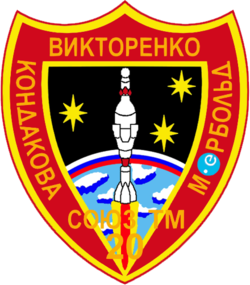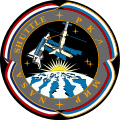This article needs additional citations for verification .(December 2013) |
 | |
| Mission type | Mir crew transport |
|---|---|
| Operator | Rosaviakosmos |
| COSPAR ID | 1994-063A |
| SATCAT no. | 23288 |
| Mission duration | 169 days, 5 hours, 21 minutes, 35 seconds |
| Orbits completed | ~2,760 |
| Spacecraft properties | |
| Spacecraft | Soyuz 7K-STM No.69 [1] |
| Spacecraft type | Soyuz-TM |
| Manufacturer | RKK Energia |
| Launch mass | 7,170 kilograms (15,810 lb) |
| Crew | |
| Crew size | 3 |
| Members | Aleksandr Viktorenko Yelena Kondakova |
| Launching | Ulf Merbold |
| Landing | Valeri Polyakov |
| Callsign | Ви́тязь (Vityaz' – Knight) |
| Start of mission | |
| Launch date | October 3, 1994, 22:42:30 UTC [1] |
| Rocket | Soyuz-U2 |
| Launch site | Baikonur 1/5 |
| End of mission | |
| Landing date | March 22, 1995, 04:04:05 UTC |
| Landing site | 50°31′N67°21′E / 50.52°N 67.35°E |
| Orbital parameters | |
| Reference system | Geocentric |
| Regime | Low Earth |
| Perigee altitude | 392 kilometres (244 mi) |
| Apogee altitude | 394 kilometres (245 mi) |
| Inclination | 51.6 degrees |
| Period | 92.42 minutes |
| Epoch | 3 November 1994 [2] |
| Docking with Mir | |
| Docking port | Core forward |
| Docking date | 6 October 1994, 00:28:15 UTC |
| Undocking date | 22 March 1995, 00:43:08 UTC |
 Soyuz programme (Crewed missions) | |
Soyuz TM-20 was the twentieth expedition to the Russian Space Station Mir. It launched Russian cosmonauts Aleksandr Viktorenko, Yelena Kondakova, and German cosmonaut Ulf Merbold.


